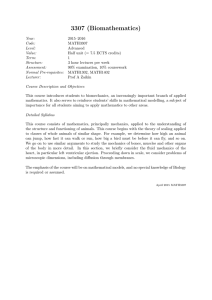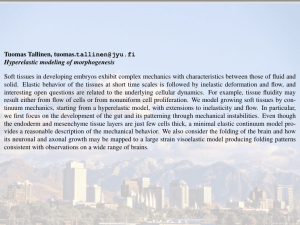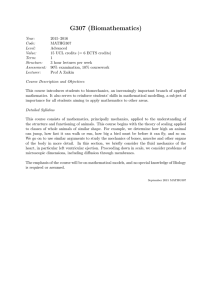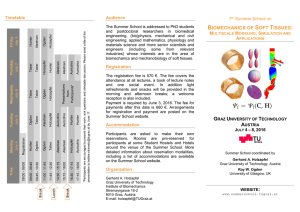M C ODELING AND
advertisement
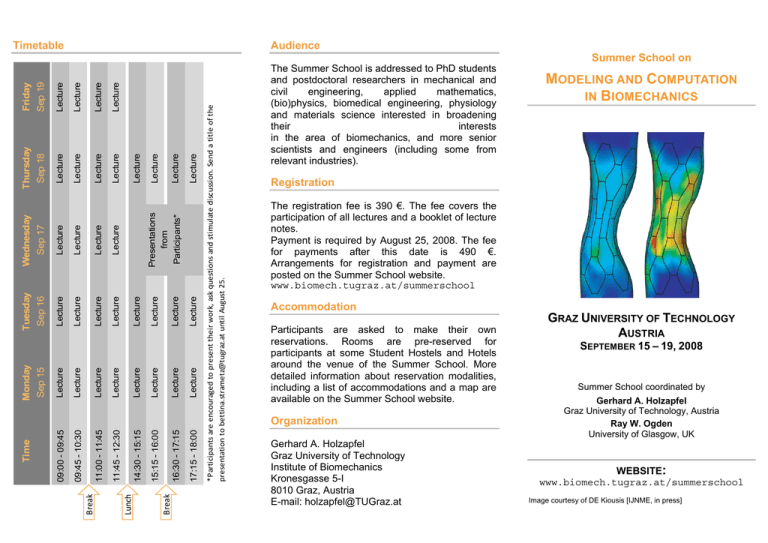
Timetable Audience Lecture Lecture 17:15 - 18:00 Lecture Lecture 16:30 - 17:15 *Participants are encouraged to present their work, ask questions and stimulate discussion. Send a title of the presentation to bettina.strametz@tugraz.at until August 25. Lecture Lecture Lecture Break 15:15 - 16:00 Lecture Lecture Presentations from Participants* Lecture Lecture Lecture Lecture Lecture Lecture 14:30 - 15:15 Lunch 11:45 - 12:30 Lecture Lecture Lecture Lecture Lecture 11:00 - 11:45 Lecture Lecture Lecture Lecture Lecture Break 09:45 - 10:30 Lecture Lecture Lecture Lecture Lecture 09:00 - 09:45 Lecture Lecture Sep 19 Sep 18 Sep 17 Sep 15 Sep 16 Friday Wednesday Time Monday Tuesday Thursday Summer School on The Summer School is addressed to PhD students and postdoctoral researchers in mechanical and civil engineering, applied mathematics, (bio)physics, biomedical engineering, physiology and materials science interested in broadening their interests in the area of biomechanics, and more senior scientists and engineers (including some from relevant industries). MODELING AND COMPUTATION IN BIOMECHANICS Registration The registration fee is 390 €. The fee covers the participation of all lectures and a booklet of lecture notes. Payment is required by August 25, 2008. The fee for payments after this date is 490 €. Arrangements for registration and payment are posted on the Summer School website. www.biomech.tugraz.at/summerschool Accommodation Participants are asked to make their own reservations. Rooms are pre-reserved for participants at some Student Hostels and Hotels around the venue of the Summer School. More detailed information about reservation modalities, including a list of accommodations and a map are available on the Summer School website. Organization Gerhard A. Holzapfel Graz University of Technology Institute of Biomechanics Kronesgasse 5-I 8010 Graz, Austria E-mail: holzapfel@TUGraz.at GRAZ UNIVERSITY OF TECHNOLOGY AUSTRIA SEPTEMBER 15 – 19, 2008 Summer School coordinated by Gerhard A. Holzapfel Graz University of Technology, Austria Ray W. Ogden University of Glasgow, UK WEBSITE: www.biomech.tugraz.at/summerschool Image courtesy of DE Kiousis [IJNME, in press] Objectives The aim of the Summer School is to present a state-ofthe-art introduction to biomechanical modeling and computation at different length scales. The emphasis is on the nonlinear behavior embracing models of molecular dynamics, single filaments, network structures, the cytoskeleton and the nucleus. Multiscale models and continuum models for soft tissues including arteries, aortic valves, cartilage and the cornea will also be presented. The Summer School will include lectures on single molecule and filament mechanics and on networkbased formulations with actin networks as an example including shear-driven visco- and poroelastic effects. Molecular dynamics models are introduced to demonstrate force-induced conformational changes that expose the vinculin-binding site under applied force along a realistic pulling direction; the molecular mechanics of actin binding proteins, i.e. alpha-actinin and filamin, is examined. Lectures introduce cellular mechano-transduction and provide an overview of cytoskeletal and nucleus models. Basic equations of continuum mechanics (kinematics, stress, balance laws), constitutive laws for elastic materials (general principles and material symmetry) and the elasticity of fiber-reinforced solids are reviewed. Lectures introduce the mixture theory for tissues and cells. The concept of flow and deformation in soft hydrated tissues, a review of physical chemistry, solvent and solute transport in tissues and across cell membranes, and Donnan osmotic swelling of charged hydrated tissues are provided. Models for soft tissues with particular reference to the fibrous structure and the effect of fiber dispersion are presented. Particular applications are: arterial tissue, discussion of the extension and inflation of an artery, residual stresses and their effect on the mechanical response, balloon angioplasty, stenting, cerebral aneurysms and AAA including growth and remodeling; aortic valves including the dynamic behavior at the cell, tissue, and organ length scales; cartilage and the cornea. Invited Lecturers Gerard A. Ateshian Columbia University, New York, USA Introduction to and applications of mixture theory for tissues and cells; governing eqs for solid-fluid mixtures and solid-solvent-solute mixtures; permeation; osmotic loading, Donnan osmotic swelling of charged tissues, examples from cartilage mechanics. Mary C. Boyce Massachusetts Institute of Technology, USA Single molecule and filament mechanics; network-based hyperelastic strain-energy formulations with actin networks as an example; shear-driven viscoelastic and poroelastic effects which get combined with the hyperelastic formulation of the prior lectures. Gerhard A. Holzapfel Graz University of Technology, Austria Introduction to blood vessels; experiments, constitutive and numerical modeling of soft tissues with applications to arteries and the cornea; balloon angioplasty; modeling of stenting; aneurysms including growth modeling. Mohammad R.K. Mofrad University of California, Berkeley, USA Protein mechanics, cellular mechanotransduction – molecular dynamic models of force-induced conformational changes exposing the vinculin-binding site; molecular mechanics of actin binding proteins (alpha-actinin and filamin); cytoskeletal and nuclear mechanics; multiscale modeling of human aortic valves. Ray W. Ogden University of Glasgow, UK Eqs of continuum mechanics; constitutive laws for elastic materials with applications to soft tissues; isotropy and anisotropy; elasticity tensors; effect of fiber dispersion; extension and inflation of a tube; residual stresses and their effect on mechanical response. Preliminary Suggested Readings G.A. Ateshian, C.T. Hung: The natural synovial joint: properties of cartilage. Proc of the Institution of Mechanical Engineers, J Eng Trib, 220:657-670, 2006. G.A. Ateshian, K.D. Costa, C.T. Hung: A theoretical analysis of water transport through chondrocytes. Biomech Model Mechanobiol, 6:91-101, 2007. E.U. Azeloglu, M.B. Albro, V.A. Thimmappa, G.A. Ateshian, K.D. Costa: Heterogeneous transmural proteoglycan distribution provides a mechanism for regulating residual stresses in the aorta. Am J Physiol Heart Circ Physiol, 294:H1197-1205, 2008. G.A. Holzapfel, R.W. Ogden: Biomechanics of Soft Tissue in Cardiovascular Systems. Springer-Verlag, Wien, New York, 2003 (see the Chapters by the Editors). G.A. Holzapfel: Collagen in arterial walls: biomechanical aspects, in P. Fratzl (ed.): Collagen. Structure and Mechanics, Chapter 11, Springer-Verlag, Heidelberg, pp. 285324, 2008. M.R.K. Mofrad, R.D. Kamm (eds.): Cytoskeletal Mechanics: Models and Measurements. Cambridge University Press, 2006. K.S. Kolahi, M.R.K. Mofrad: Molecular mechanics of filamin's rod domain. Biophys J, 94:1075-83, 2008. M. Kroon, G.A. Holzapfel: Estimation of the distributions of anisotropic, elastic properties and wall stresses of saccular cerebral aneurysms by inverse analysis. Proc R Soc Lond A, 464:807-825, 2008. J.S. Palmer, M.C. Boyce: Constitutive modeling of the stressstrain behavior of F-actin filament networks. Acta Biomater, 3:597-612, 2008. R.W. Ogden: Elements of the theory of finite elasticity, in Y.B. Fu, R.W. Ogden (eds.): Nonlinear Elasticity: Theory and Applications. Cambridge University Press, pp. 1-57, 2001. G. Sommer, T.C. Gasser, P. Regitnig, M. Auer, G.A. Holzapfel: Dissection of the human aortic media: an experimental study. J Biomech Eng, in press. E.J. Weinberg, M.R.K. Mofrad: Transient, three-dimensional, multiscale simulations of the human aortic valve. Cardiovasc Eng, 4:140-55, 2007.

